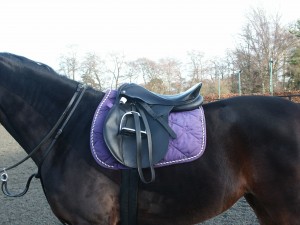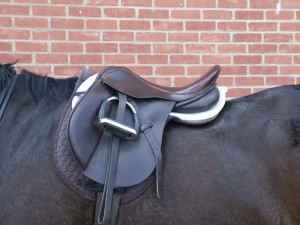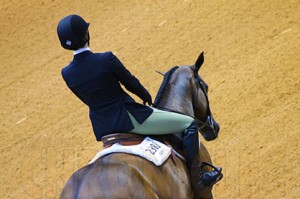Ill-Fitting Saddles Are Culprits For Horse AND Rider Back Pain, New Study Suggests
Saddle Research Trust
Ill-fitting saddles are not only associated with back muscle asymmetry, a stilted gait, and back pain in the horse, but they are also associated with back pain in the rider. These are the key conclusions from a new study looking at saddle fit, back shape, and horse as well as rider health. However, identifying the order of cause and effect is complex. The results strongly suggest that saddle fit should be checked regularly and that riders and trainers should be encouraged to learn how to identify ill-fitting saddles. In addition, the study highlights the importance of being able to recognize lameness, saddle slip, and rider crookedness.
Although sport horses are becoming increasingly valuable, previously there has been little objective exploration of the horse-saddle-rider interaction. In particular, there has been little work on the potential consequences of a saddle not fitting the horse or the saddle not allowing the rider to sit in a position in which they can ride in balance.
The study1 was conducted by Dr Sue Dyson, Head of Clinical Orthopaedics at the Centre for Equine Studies at the Animal Health Trust (AHT) and Line Greve, PhD Student at the AHT and was supported by World Horse Welfare (WHW).

The seat of the saddle tips back. The panels of the saddle have contact with the horse’s back at the front and the back but not under the middle of the saddle. This is called bridging and causes focal pressure under the front and back of the saddle.
A clinical assessment of the horse and rider was performed and data was subsequently obtained from the same riders via an online questionnaire, without the riders being aware of the link between the two initiatives. The horses were selected from a variety of work disciplines, were in regular work, and were presumed by their riders or owners to be sound. Asymmetries of the back were assessed and any presence of lameness observed. Saddle slip, fit, and management as well as rider straightness were evaluated from both the clinical examination and questionnaire responses.
A total of 205 riders responded to the questionnaire. Ill-fitting saddles were identified in 43% of horses during the clinical assessment. Saddle slip was observed in 14.6% of horses, which was significantly associated with hindlimb lameness or gait abnormalities. However, only two riders had linked saddle slip and lameness despite strong associations between a history of lameness, history of ‘back problems’, and history of saddle slip.
38% of riders had back pain and in the clinical assessment this was associated with ill-fitting saddles and either a reduced airborne phase of the step in all four limbs or a stiff, stilted canter, suggesting pain. Rider back pain was also associated with rider crookedness. Well-fitted saddles were associated with frequent saddle fit check. Horses ridden by expert riders were less likely to have asymmetry of the back compared with those ridden by non-expert riders.
“Ideally, saddle fit should be checked more often than once a year to reduce the instances of ill-fitting saddles,” said Line Greve. “Yet, this isn’t the whole solution because worryingly, 30% of horses that had their saddles checked at least once yearly still had an ill-fitting saddle. What is unknown is whether these saddles had ever fitted correctly or whether a properly qualified saddle fitter was responsible for the fitting. It can only be of benefit for riders, trainers, and other associated professionals to become more educated about the complexity of the links between lameness, saddle slip, ill-fitting saddles, and rider crookedness.”

The seat of the saddle tips backwards which, with a rider, results in abnormal pressure under the back of the saddle. The numnahs tend to ruckle up behind the saddle.
The full results of the study will be presented at the second Saddle Research Trust International Conference, to be held in Cambridge on November 29, 2014 at Anglia Ruskin University. The conference is supported by World Horse Welfare (WHW) and is approved by the British Equine Veterinary Association (BEVA). Advance tickets are £100 or £150 on the door – email research@saddleresearchtrust.com or telephone 07775 912202 to reserve your place. To find out more and to download a copy of the program visit www.saddleresearchtrust.com
1Saddle fit and management: an investigation of the association with equine thoracolumbar asymmetries, horse and rider health L. Greve and S.J. Dyson, Centre for Equine Studies, Animal Health Trust, Lanwades Park, Kentford, Newmarket, Suffolk, CB8 7UU, UK.











